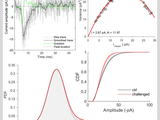6,160 results
Find local maxima \ peak positions in noisy 2D arrays
fastpeakfindA simple and fast 2D peak finder. The aim was to be faster than more sophisticated techniques yet good enough to find peaks in noisy data. The code analyzes noisy 2D images and find peaks
Scripts, functions, and mat files to locate, measure, and fit the peaks and valleys in noisy time-series data sets.
. Determines the position, height, and width of each peak by least-squares curve-fitting. It can find and count over 10,000 peaks per second, and find and measure 1800 peaks per second, in very large signals
Find peaks in vector
Specify a vecter, a minimum peak separation, and a minimum peak height, and this function will find the peaks.. about 250 times faster than findpeaks
Quickly finds local maxima (peaks) or minima (valleys) in a noisy signal.
This function quickly finds local peaks or valleys (local extrema) in a noisy vector using a user defined magnitude threshold to determine if each peak is significantly larger (or smaller) than the
Help you find peak value from a lot of data.
It's a simple function. Can help you find peak value from a lot of datas. It contains some demos.It's my first time to submit file, thanks for your using.
Easily allows you to automatically find, plot, and label local maxima (peaks) and local minima on MATLAB
Easily allows you to automatically find, plot, and label local maxima (peaks) and local minima on MATLABThis code requires the MATLAB Signal Processing Toolbox, which can be downloaded here
Modified SGP4 code for GPS interface
Simulate satellite beacon signal propagation
Find peaks in 2D data just as with Matlab's 'findpeaks' function
Fast and effective 2D peak finding algorithm returning peak locations and values. Accepts 2D arrays as an input (for instance, image acquired with a camera from some optics experiment). Various
Sound processing for Nucleus cochlear implant systems
Keypress operated interactive peak detector function.
ipeak(DataMatrix,PeakD,AmpT,SlopeT,SmoothW,FitW,xcenter,xrange,MaxError,positions,names)iPeak is a keyboard-operated Interactive Peak Finder for time series data. Expected input forms: ipeak(y); %
Estimates the location and magnitude of the peak of a continuous function between samples.
Sometimes it is important to be able to estimate the peak of a sampled continuous function between the samples. This is called subsample peak interpolation and is used in radar, delay estimation, and
Complements find peaks function with the possibility to find all peaks, both local maximums, and local minimums.
Besides complementing find peaks function with the possibility to find all peaks, both local maximums, and local minimums.This also provides a possible workaround for the findpeaks bug pointed out by
performs HHT on signal & IMF is plotted for Condition monitoring of vibration based bearing fault
Up-sample and filter noisy data to find peaks without using derivatives.
, 2013.peakfind(x_data,y_data)peakfind(x_data,y_data,upsam)peakfind(x_data,y_data,upsam,gsize,gstd)peakfind(x_data,y_data,upsam,htcut,'cuttype')peakfind(x_data,y_data,upsam,gsize,gstd,htcut,'cuttype')[xpeaks]=peakfind()[xout,yout,peakspos]=peakfind()This function finds peaks without taking first or second derivatives, rather it uses local slope features in a given data set. The function has four basic modes. Mode 1: peakfind(x_data,y_data) simply
This submission is a realization of the Hilbert-Huang transform (HHT).
Calculates Impulsive noise metrics for hazardous acoustic noise assessment.
A signal analysis toolbox aimed to especially to gravitational wave detection
Find matching features in pairs of images using normalised cross-correlation: class file and demo.
patch of one image, compute its sliding cross-correlation with the other image, and find a peak. This submission supplies a class which implements this method.There are many other ways of finding
3-D Ray Trace function for refractive propagation
Matlab library to visualize the avalanche and power law characteristics of the sandpile model Edit
This exercise shows how the method of linear predictive coding (LPC) models a speech frame.
This exercise utilizes four programs to train a Bayesian classifier and classify frames of signals.
This exercise computes the frequency response of a p-tube model of a human vocal tract.
Matlab toolbox for separation techniques hyphenated high resolution mass spectrometry
a software, it is a collection of classes and functions that allow recovering MS scans from mzML files and performed transformation (baseline drift correction, peak picking, centroid algorithms…), As
some useful spherical harmonics routines
function valuesf(theta,phi) and the derivativesof f w.r.t theta and phi. Can be usedfor finding peaks of spherical functions[4] implement the spherical harmonics rotation algorithm of Ivanic and Ruedenberg
Find local peaks or troughs in a vector
NOTE: this function is now available from the IoSR Matlab Toolbox as iosr.dsp.localpeaks. ------------------------- LOCALPEAKS Find local peaks and troughs in a vector SYNTAX peaks =
Calculate RT, DRR, Cte, and EDT for impulse response file
) will be returned for each channel. The function returns a 1xN vector of RTs, where N is the number of channels in the audio file. The function determines the direct sound as the peak of the squared
Apply a near-ideal low- or band-pass filter.
Stacked line plots from a matrix or vectors
Return sound pressure levels of pure tone frequencies at specified loudness level(s).
Produce an array of responses from a fourth-order Gammatone filter via FFT
align=true, fine structure and envelope alignment is applied so that the impulse response peaks occurs at t=0.[bm,env] = gammatoneFast(...) returns the instantaneous envelopes env for each filter.[bm,env,delay
Quantile-quantile plot with patch option
This function finds dominant peaks and local valleys of an image histogram
This function finds dominant peaks and valleys of an image histogram. Minimum peak distance and averaging filter size can be changed to suit your need. Although, the function is originally written
Draw a box plot with various display options
Find peaks in data using a scale-space approach. It is efficient and requires very few parameters.
-------------------------------------------------------------Scale-space peak picking------------------------This function looks for peaks in the data using scale-space theory. input : * V : data
Visualization and analysis of an Electrocardiogram Signal
Version 1.0.0
Constantino Carlos Reyes-AldasoroLive Script shows how to find data peaks from EKG, how to refine peaks from data, and infer heart rate from peaks of Electrocardiogram data
The Electrocardiogram Live Script uses the Signal Processing Toolbox to find peaks of data from an EKG and shows how to refine the peaks based on your data. The Live Script also shows how to gather
Algorithms for estimation of respiratory rate from the electrocardiogram and photoplethysmogram
Quantiles of a sample via various methods
Acycle: Time-series analysis software for research and education
Matlab GUI for analyzing Gel Lane Images
Automatic find peaks and associate each point to a peak in a vector
function [peaks,groups,criterion] = peaksandgroups(V,select,display)% -------------------------------------------------------------% Find peaks and link each data point to a peak, in effect
Track optical distortions in a checkerboard pattern with high accuracy in real-time using the FCD method
Simple MATLAB Code for the paper "Clustering by fast search and find of density peaks"
This MATLAB Code (i.e., Density-based Clustering) is originated from the wonderful paper "Alex Rodriguez & Alessandro Laio: Clustering by fast search and find of density peaks, Science 344, 1492
Find sub-sample location of global maximum in a 2-dimensional numerical matrix.
This small contribution is useful in cases where you search for the position of a peak within an intensity matrix (correlation or energy fields) of low resolution. Since this is only a 2nd-order-fit
Finds peaks, locations, fwhms and area in signal.
Very lean an simple code that automatically finds major peaks, their locations, fwhms and area in a given signal y versus x. Requires no input parameters. The output is a matrix with peaks sorted in
Calculate the long-term average spectrum of a signal
LTAS for each corresponding row/column/etc. S = LTAS(X,FS,'PARAMETER','VALUE') allows numerous parameters to be specified. These parameters are:- 'dim' : {find(size(X)>1,1,'first')} | scalar
3-D Propagation simulator for turbulent media
Simulate Propagation in 2-D
A library for scintillation channel modeling applications.
Package of scripts used to track organelles as described in Valente et al. 2022
Perform windowed smoothing on a vector using mathematical functions
Find peaks in 1D data | Matlab findpeaks equivalent
Peak finding algorithm for essential signal processing. Returns peak amplitudes and locations. Various filters can be selected such as minimal absolute value, threshold above the immediate
Find Peaks of the signal and stores the answer in excel
find peaks program to find peaks i have faced problem in findpeaks.m so i have made my code to find peaks of the signal. it find peaks of the signal from excel file and stores peaks value in excel
相机内参验证工具APP
Data import and peak search
MATLAB script which can be used to complete a peak search on a spectrum trace extracted from an RSA6100A Real-Time Spectrum Analyzer. Definable Parameters - Start Frequency- Stop Frequency- RBW
Toolbox for batch analysis of postsynaptic current from neuronal recording
Apply 1/NOCT-octave smoothing to a magnitude spectrum.
Producing high- and low-resolution smoothers by means of Spectral Analysis

















































